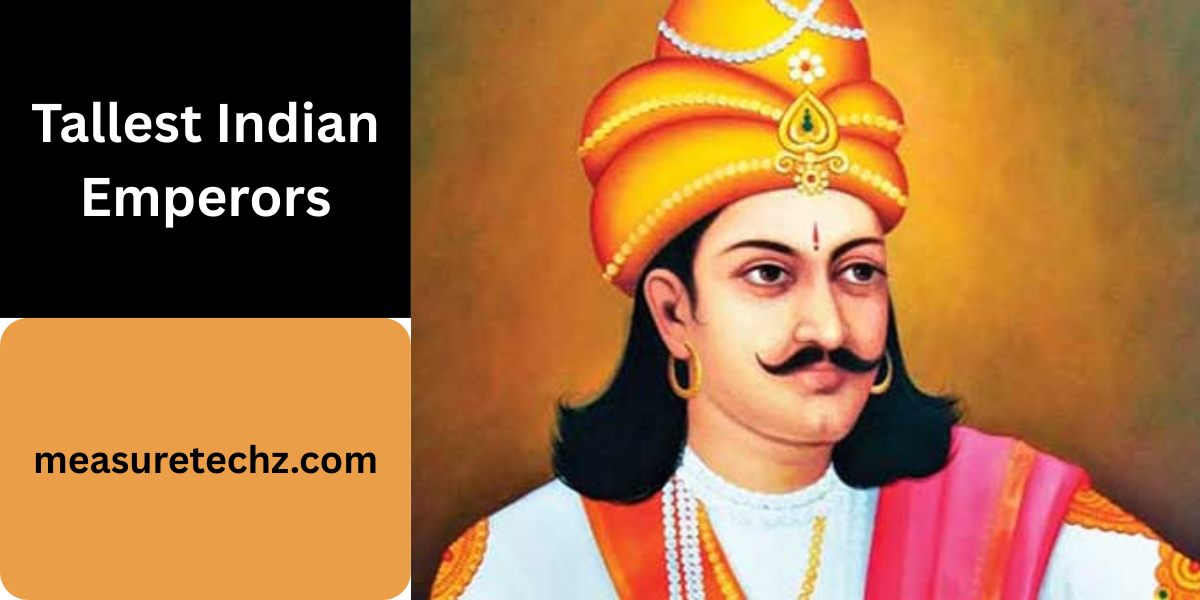Throughout history, Indian emperors have fascinated us with their courage, leadership, and grand empires. But beyond politics and warfare, many rulers were remembered for their physical stature, often described in awe by chroniclers and foreign travelers. While some accounts are well-documented, others border on legend—leaving us to separate fact from myth.
In this article, we’ll explore the 8 tallest Indian emperors that ever lived, drawing from historical records, Mughal memoirs, Rajput ballads, and European accounts. You’ll discover which rulers were genuinely tall and which became larger-than-life through folklore.
List of the 8 Tallest Indian Emperors That Ever Lived
1. Emperor Ashoka the Great (Maurya Dynasty)
- Height (claimed): 7.5 feet
- Reign: 268 – 232 BCE
Ashoka the Great, one of India’s most celebrated emperors, is often described in Buddhist texts as exceptionally tall, sometimes said to exceed 7 feet in height. While historians debate the accuracy of this claim, his commanding presence was undeniable. Legends suggest his massive frame matched his larger-than-life role in spreading Buddhism across Asia.
Historical note: Such height is likely exaggerated, but symbolic references in Buddhist scriptures often used physical grandeur to emphasize moral greatness.
2. Maharana Pratap (Mewar, Rajput Dynasty)
- Height (claimed): 7 feet 5 inches
- Reign: 1572 – 1597 CE
One of India’s most legendary warriors, Maharana Pratap is frequently described as a giant among men. Folklore claims he stood 7’5” tall, wore armor weighing 72 kg, and carried a spear of 80 kg.
However, more reliable sources suggest his height was closer to 5’7”, and the extreme numbers were products of “legenditis.” Regardless, his reputation as a towering figure physically and symbolically remains central to Rajput pride.
3. Emperor Akbar the Great (Mughal Dynasty)
- Height: Approximately 5’7” – 5’10”
- Reign: 1556 – 1605 CE
Akbar, though not extraordinarily tall by modern standards, was often described by contemporaries as well-built and imposing. European travelers noted his broad chest and strong physique.
His presence was so commanding that it often gave the impression of greater height—a valuable trait for a ruler who united much of India under one throne.
4. Emperor Jahangir (Mughal Dynasty)
- Height (described): Tall and slender
- Reign: 1605 – 1627 CE
Sir Thomas Roe, the English ambassador to Jahangir’s court, described the emperor as tall, graceful, and slender. Unlike his father Akbar, Jahangir had a more delicate build, but his height gave him a regal bearing that impressed foreign envoys.
5. Emperor Aurangzeb (Mughal Dynasty)
- Height (recorded by Bernier): Over 6 feet
- Reign: 1658 – 1707 CE
François Bernier, a French traveler in Aurangzeb’s court, wrote that the emperor was “tall and lean, with a noble air.” At a time when the average height in India was significantly shorter, Aurangzeb’s stature would have made him appear towering.
6. Alauddin Khilji (Delhi Sultanate)
- Height (described): Above average, strong build
- Reign: 1296 – 1316 CE
Alauddin Khilji, the powerful Sultan of Delhi, was admired for his physical strength and military energy. Chroniclers described him as a tall man with a formidable presence. His height and robust build were factors that enhanced his fearsome reputation, especially against Mongol invasions.
7. Emperor Chandragupta Maurya (Maurya Dynasty)
- Height (described by Greek accounts): Tall and imposing
- Reign: 321 – 297 BCE
Greek historians who met Chandragupta Maurya described him as “of commanding stature.” Considering that the Greeks often compared Indian rulers to their own warriors, this implies Chandragupta was taller than average. His height, coupled with his charisma, helped him establish the vast Mauryan Empire.
8. Tipu Sultan (Mysore Kingdom)
- Height: About 6 feet
- Reign: 1782 – 1799 CE
Tipu Sultan, the “Tiger of Mysore,” was known for his athletic build and tall stature. British accounts frequently mentioned that Tipu stood out among his contemporaries due to his height and energy. His physique added to his image as a relentless warrior who resisted British colonization.
Were They Really That Tall? Separating Fact from Legend
- Exaggerations in folklore: Maharana Pratap’s “7.5 feet” claim is likely a legend.
- Symbolism: Ancient texts often used physical size to symbolize greatness.
- Foreign perspectives: European travelers frequently described Indian rulers as tall, perhaps because average European height at the time was slightly shorter.
- Realistic heights: Most emperors likely ranged from 5’6” to 6’1”, which was considered tall for their times.
Frequently Asked Questions (FAQ) on Tallest Indian Emperors
1. Who was the tallest Indian emperor in history?
Maharana Pratap is often claimed to be the tallest Indian emperor, with legends stating he was 7 feet 5 inches tall. However, historians believe this height is exaggerated, and he was likely closer to average height.
2. Was Ashoka the Great really over 7 feet tall?
Buddhist texts describe Emperor Ashoka as being over 7 feet tall, but these accounts are considered symbolic rather than factual. His “great height” often represented his moral and spiritual stature.
3. Which Mughal emperor was the tallest?
Among the Mughal rulers, Aurangzeb was described by French traveler François Bernier as over 6 feet tall, making him one of the tallest Mughal emperors.
4. How tall was Akbar the Great?
Emperor Akbar was around 5’7” to 5’10” tall, which was considered tall for his era. Though not extraordinarily tall, his broad chest and strong build gave him a commanding presence.
5. Did Maharana Pratap really wear 72 kg of armor?
According to folklore, Maharana Pratap’s armor weighed 72 kg and his spear was 80 kg. Most historians agree these numbers are exaggerations to highlight his legendary strength.
6. Who was the tallest South Indian ruler?
Tipu Sultan of Mysore was around 6 feet tall, which made him stand out in his era. British accounts often emphasized his tall and athletic build.
7. Were Indian emperors taller than common people?
Yes. Many rulers, such as Chandragupta Maurya and Aurangzeb, were described as taller than the average man of their time (around 5’3” – 5’5”). Their stature often enhanced their royal image.
8. Are the heights of Indian emperors historically accurate?
Not always. Many claims about their extreme height come from legends, ballads, and symbolic descriptions. Verified accounts suggest most emperors were between 5’6” and 6’1”, which was tall for their times.
Conclusion
Height has always been associated with power, strength, and leadership. While not every emperor on this list was a true “giant,” their stature—both physical and symbolic—left a lasting impact on Indian history.
From Ashoka’s legendary 7-foot frame to Aurangzeb’s lean 6-foot height, these rulers stood tall in every sense of the word. Whether fact or folklore, their larger-than-life presence continues to capture our imagination.

